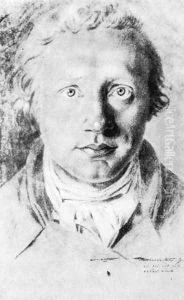Asmus Jakob Carstens Paintings
Asmus Jakob Carstens was a notable figure in the realm of European art, particularly recognized for his contributions to the Neoclassical movement. Carstens was born on May 10, 1754, in St. Jürgen, near the city of Schleswig in Duchy of Schleswig, which was then under Danish rule. His early life was marked by modest circumstances, and he initially embarked on a career in law. However, his passion for art prevailed, and he soon devoted himself entirely to painting.
Carstens' artistic pursuits led him to Copenhagen, where he studied at the Royal Danish Academy of Fine Arts. His time at the academy, however, was not particularly fulfilling, and he found the instruction there to be conservative and stifling to his creative aspirations. Seeking a more vibrant artistic environment, Carstens moved to Italy in 1783, where he was deeply influenced by the works of ancient Greek and Roman art as well as the Renaissance masters. Rome, the epicenter of Neoclassicism, was particularly impactful on his artistic development.
In Italy, Carstens began to develop his distinctive style, characterized by the use of mythological and allegorical subjects, executed with an emphasis on linear clarity and simplicity of form—hallmarks of the Neoclassical ideal. He sought to revive the grandeur and ethos of ancient art, often focusing on heroic or philosophical themes that emphasized moral virtue and human dignity. Despite his talent, Carstens struggled with financial difficulties throughout his life, which hindered his ability to gain widespread recognition during his lifetime.
Carstens' later years were marked by a move to Berlin in 1792, where he was welcomed by the art community and granted a stipend by the King of Prussia. This period was his most productive, and he created some of his most significant works, such as 'The Night with her Children Sleep and Death' and 'The Genius of the Arts'. Unfortunately, his time in Berlin was short-lived; Carstens died on May 25, 1798, at the age of 44, after a battle with tuberculosis.
Despite his early death, Asmus Jakob Carstens left behind a body of work that would have a lasting impact on the course of European art. His dedication to the classical traditions and his visionary approach to Neoclassicism influenced a generation of artists and helped to shape the aesthetic preferences of the time. His drawings, in particular, were praised for their innovative compositions and expressive line work, and they continue to be studied for their artistic merit and historical significance.
